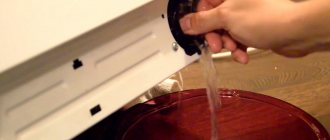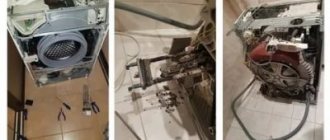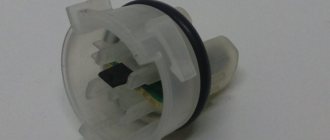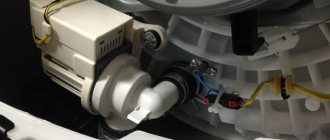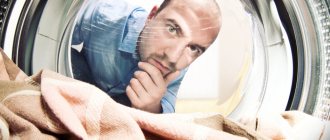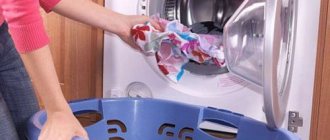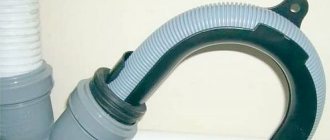Lack of spinning is one of the most common signs of a breakdown of an Electrolux washing machine.
To eliminate this malfunction, diagnostics of the electronic unit, bearings, shock absorbers and control sensors may be required.
The cause and cost of repairs can be determined by the error code and associated symptoms. Let's look at the reasons why the Electrolux washing machine does not spin clothes well.
Choose a different mode
If you find that your laundry remains wet after washing, do not rush to call a professional. The most common and common reason that the machine does not spin is the use of a program in which spinning is not used. Such programs can be:
- wool washing;
- washing silk;
- gentle wash.
To make sure that this is the case, use the instructions for the machine (if you don’t have it on hand, find it on the Internet). If the mode you are using does not involve spinning, simply run it separately at the end of the wash. The advantage is that these problems are not related to technical faults and can be fixed without doing the repairs yourself or taking the car to a service center.
Also, the spin can be forcibly turned off even in the mode in which it is provided. Check that you are not faced with exactly this situation.
Instructions for disassembling a household appliance
The disassembly process begins with preparation, it is important:
- Prepare your tools in advance. You will need screwdrivers, pliers, and open-end wrenches. Additionally, you should stock up on WD-40 spray or an equivalent.
- Prepare the place. The washing machine is a large piece of equipment, and you need enough free space to disassemble it.
- Unplug the machine from the socket.
- Drain off any remaining liquid and remove the laundry from the drum.
The next step will be to dismantle the external components of the washing machine. You need to remove the lid, walls, detergent compartment, to do this:
On the back you need to find and unscrew two screws and remove the panel. The cuvette for household chemicals must be removed all the way and pressed on the “tab”, it is located in the rinse aid compartment. Unscrew the fasteners that are under the powder box, additionally unscrew the hatch fixing screws
The hatch clamp should be slightly pryed with a screwdriver and carefully pulled off. There are screws to the left of the electronic panel; you need to remove them and then pry up the fasteners to remove the electronic module
Once the module is pulled out, you will have access to the screws holding the back and front panels.
Instructions:
- first you need to disconnect the terminals from the power unit, then turn the pulley with one hand and tighten the belt with the other;
- you need to unscrew the screws securing the engine;
- after unscrewing, the motor needs to be moved a little and pulled out;
- Then the pump wires are disconnected, the screws are unscrewed - to move the pump it must be turned clockwise;
- removing the wiring and sensor and heating element, then unscrew the nut located in the center, pull out the heating unit using swinging movements;
- the screws of the counterweights are unscrewed, the components are dismantled;
- After this, all that remains is to remove the dispenser pipes, the filling valve wiring and the pressure switch.
Laundry was folded incorrectly
As a rule, modern models of washing machines have an overload detection function (this is a situation when the weight of the laundry is too large and the machine cannot cope with the load). If your machine does not have such a mode, trouble occurs.
- The laundry is washed without any visible problems.
- When the spin starts, the machine tries to spin the drum, but this does not happen due to the heavy weight of the laundry.
- Attempts are repeated several more times.
- If the drum does not start rotating, the washing machine stops working, and you end up with wet laundry on your hands.
If the spin does not work precisely for this reason, at the end of the wash you should try to take out the laundry and spread it evenly over the drum. This will prevent the laundry from forming a heavy lump and reduce the load on the drum.
The main reasons why the Electrolux washing machine does not spin clothes well, solutions
Lack of spinning is one of the most common signs of a breakdown of an Electrolux washing machine.
To eliminate this malfunction, diagnostics of the electronic unit, bearings, shock absorbers and control sensors may be required.
The cause and cost of repairs can be determined by the error code and associated symptoms. Let's look at the reasons why the Electrolux washing machine does not spin clothes well.
There is a lot of water in the tank
Another reason that the machine does not start spinning clothes may be that there is too much water in the tank. Before spinning, the washing machine drains the water, and during spinning it additionally gets rid of water coming out of the laundry being spun. If you suspect that the machine has stopped spinning because of this, do the following:
- unscrew the drain filter;
- check it for unnecessary items, then clean it;
- Check to see if there is a blockage in the drain hose or in the drain pipe leading to the pump from the tank. If there is a blockage, remove it;
- put the hoses and filter back in place and check the operation of the machine again.
If the problem persists, listen to the pump: it should hum. If this does not happen, the drain pump may need to be replaced.
Diagnostics of the Electrolux automatic washing machine
Modern washing machines are equipped with a self-diagnosis function . If individual systems of the device are faulty, then during an automatic test the computer records deviations from the norm and displays an error code on the display.
Electrolux machines have a diagnostic (service) mode, which can be entered by holding down the start button and the one next to it, and then turning on all the washing modes one by one.
| Type of failure | Signs | Error code | What is needed for diagnosis |
| Drive belt problems | The machine does not rotate the drum or cannot reach high speeds, which reduces the spin quality | EA31-EA6 | Remove the back panel, inspect the belt, rotate the drum |
| Drain pump failure | The spin cycle does not start; there is water in the tank. The pump does not buzz at the end of the rinse program | E21, EF1, EF3 | Remove the drain filter and pump, inspect the impeller, check the resistance of the pump |
| Clogged drain system | The pump hums, but does not drain water, spinning is impossible | From E20 to E24, EF1 | Inspect the drain pipe, filter and sewer system |
| Bearing wear | The drum does not rotate. There may be visible streaks of rust on the tank. With non-critical wear, the SMA erases and wrings out, but is very noisy | In some cases - E50 | Remove the back panel, inspect the tank, check the drum for jamming |
| Problems with the pressure switch | The water remains inside the tank, although the hum of the pump can be heard. SMA does not switch to the spin program | From E31 to E35, E38, E39 | Remove the pump and pressure switch, check the condition of the hose and the sensor resistance |
| Incorrect operation of the tachometer | Spin is weak or absent | E52 | Remove the motor, check the condition and resistance of the winding. The tachometer is examined simultaneously with the engine |
| Damage to the engine, tachogenerator | There is no rotation, you can’t hear the motor running | E50-E59 | |
| Motor brush wear | The drum does not rotate. If the brushes are worn uncritically, the SMA presses out, but cannot reach high speeds | E50, E52 | Remove and disassemble the engine |
| Malfunctions of the electronic module | Depends on the nature of the malfunction | From E53 to E56, E24, E98, etc. | Disassemble the SMA, inspect the contacts for breaks and check the condition of the board tracks |
| Overload, imbalance of laundry | Spin stops immediately after it starts | EF5 | Place the machine on a flat surface and check the weight of the loaded laundry. |
| Damage to shock absorbers | There is no spin, although the wash and rinse programs are turned on | — | Remove the top cover of the SMA, press on the tank. If the shock absorbers do not dampen vibrations, then remove the rear panel and inspect their condition. |
How to determine a fault code without a display?
Some SMA models are not equipped with a display. In this case, error codes can be recognized by the blinking or lighting of the indicators. The method for determining a malfunction depends on the type of electronic module:
- EWM1000 . The error number is transmitted by two indicators located near the “Start” button. The number of flashes of the first light indicates the first digit of the code, and the second - the last.
- EWM2000 . To determine the error code, the new generation ECU uses an indicator system located on the right side of the dashboard. The first digit is determined by the numbers of the light bulbs in the top row, and the second - in the bottom.
Hall sensor does not work
A Hall sensor or tachometer is a device inside the washing machine that detects and controls the rotation speed of the drum. If it is faulty, the machine may incorrectly determine the number of revolutions, causing the spin to be either unsatisfactory or completely absent.
The main culprit for tachometer failure is frequent loading of too much laundry into the machine. In addition, the Hall sensor may become loose or the contacts may come loose.
In order to check the operation of the tachometer, you will have to remove the motor. After this, check all contacts, cleaning them if necessary, and also tighten the fastening. If this does not help and the sensor itself is faulty, you will have to buy a new one.
Repair
After determining the cause of the malfunction, you can begin to restore the SMA. To do this, it is necessary to disassemble the device and replace non-repairable parts.
Cleaning the drain system
If the SMA does not start spinning due to lack of drainage, then you need to check the filter and drain pipe for blockages. To do this you need:
- turn off the machine from the network;
- place a wide, low container under the right front side of the device;
- remove the front lower panel, behind which is the drain filter handle;
- turn and remove the part;
- drain the water, periodically pouring it out of the container;
- clean the filter and part slot;
- disconnect the drain pipe, check it for passability under running water;
- Reinstall the pipe and filter, turn on the drain program.
Replacing or restoring the drain pump
If the filter and pipe are not clogged, but water continues to stand in the tank, then the problem lies in the drain pump. This part is repairable only in 2 cases:
- If the impeller is jammed by a foreign object (without breaking the blades).
- If the contacts have come loose or oxidized.
In case of other malfunctions, the pump is replaced with a new one.
Drive belt
The belt is located on the back of the tank, so it can be easily changed independently. The tape is removed from the shaft and installed with similar characteristics.
We repair the engine
To repair the motor you may need:
- cleaning and restoration of contacts;
- replacing brushes;
- restoration of connections (wires, terminals);
- installing a new thermistor;
- replacing the stator winding.
If the rotor needs to be replaced or the broken parts of the motor are filled with compound (epoxy resin), then the engine is unsuitable for repair.
Bearings
To replace the bearings, as a rule, a technician is invited from the service center. In some cases, it may be necessary to transport the SMA to a workshop. Specialists disassemble the tank, install new bearings and seals, and then check the balance of the drum as it rotates.
Shock absorbers
To replace shock absorbers you must:
- Remove the top and back panels of the machine.
- Find and remove the mounting parts under the tank.
- Select spare parts with similar configurations.
- Install a new set and run the spin program to check.
In some SMA models, shock absorbers are located in such a way that replacing them requires complete disassembly of the tank. In this case, it is better to contact a professional.
RPM sensor
The tachometer, or Hall sensor, rarely fails. As a rule, most problems are caused by loosening of its fasteners or poor contact with the computer.
To check and repair you need:
- remove the engine;
- inspect and clean the contacts (for example, with technical alcohol);
- tighten the sensor fastenings;
- Reinstall the motor and turn on the spin cycle.
If the problem persists and the engine is working properly, you will have to buy a new tachometer.
Pressostat
To repair the level sensor, you need to remove the top panel, find the round part and inspect its contacts. If the pressure switch is connected to the wiring, then:
- Disconnect the hose connected to the sensor and prepare a tube of the same diameter.
- Blow into the tube.
- If clicks are not heard when air is supplied, replace the pressure switch; in other cases, replace the damaged hose or clean the pressure sampling chamber.
Electronic module
To restore the ECU operation you may need:
- replace burnt radio elements (relays, capacitors, etc.);
- clean the board from oxides;
- solder burnt tracks;
- reprogram the module (to do this, memory is removed from it).
The motor is broken
The main culprit for breakdowns or unsatisfactory engine performance is wear of the brushes - because of this, the engine cannot accelerate the drum to a sufficient number of revolutions for spinning. If you want to try to fix the engine yourself, you will have to get to it first. To do this, follow these steps.
- Remove the washing machine body.
- Disconnect the belt from the motor and disconnect the wires.
- Unscrew the engine.
Since the tachometer is located near the motor, you can check it at the same time.
Check the brushes on the motor, test the coils and windings. If something is faulty, replace it. If the problem is too large, the easiest way is to replace the motor completely.
List of required tools
To correctly disassemble the washing machine, a home craftsman will need the following tools:
- wrenches (size 8, 9, 19);
- service hook;
- screwdrivers (classic flat and Phillips);
- pliers and wire cutters used for self-clamping clamps;
- ordinary wire cutters;
- pliers with an insulated rubberized handle;
- bent long pliers.
Almost all of these items will definitely be found in your home arsenal, and the missing items will simply need to be purchased at a hardware store or borrowed from friends or neighbors.
If the machine runs for a long time, some screws may “stick” to the cells. Unscrewing them will be problematic, so it makes sense to use WD-40. A few drops will soften the joints and facilitate correct unscrewing of the connecting parts.
In addition to all the items listed above, it is worth stocking up on a medium-sized basin, where it is convenient to drain the remaining water in the hoses, and several microfiber cloths. They can be used to wet your hands, wipe the internal parts and collect the remaining working fluid that has spilled from the tubes from the floor.
The control module has failed
The control module is the command center of the washing machine. All signals pass through it, after processing which the necessary commands are sent to other parts of the machine. If you have checked the mode, the weight of the laundry, the water in the tank, the tachometer and the engine, the only option left is with the module. Unfortunately, you won’t be able to check it yourself, let alone repair the module - you’ll have to call a technician.
Next, we will consider situations when the spin works, but there are “minor troubles.” If you hear extraneous knocking noises while spinning or washing clothes, most likely there are foreign objects in the space between the tub and the drum. To correct the situation, it is necessary to remove the heating element and remove foreign objects. Although the situation, as a rule, does not affect the quality of washing or spinning, you should not delay it: foreign things in the machine can lead to its complete malfunction.
Also, extraneous sounds in the washing machine may indicate wear of the bearings. In this case, disassemble the car and check if they are leaking. If any of the problems cannot be solved on your own, do not worry, not everything can be solved without special tools and knowledge. Just contact a specialist - even if it hits your wallet a little, it will help you save both time and nerves.
Interesting:
- Electrolux washing machines
- Electrolux dishwasher dimensions
- Electrolux dishwasher repair
- How does an Electrolux washing machine work?
- Reviews of built-in washing machines
- The quietest and most silent dishwashers
Reader comments
- Share your opinion - leave a comment
Cost of calling a technician
Depending on the cause of the breakdown, the cost of repairing the AMS is:
- engine - from 1600-2300 rubles;
- drive belt - from 1000 rubles;
- shock absorbers - from 2500 rubles;
- sensors - from 1800 rubles;
- drain pump - from 1800 rubles;
- control unit - from 2300-2900 rubles;
- bearings - from 3800 rub.
The cost of repairs does not include the price of spare parts that will be required for replacement. In addition to the nature of the malfunction, the price is affected by the model of the device and the complexity of the work.
For example, repairing an ECU may cost more than replacing a complete module. But considering the price of the part itself, installing a new board will cost more. If repairs are needed urgently, and diagnostics require transportation to a service center, then the cost may increase.
How to avoid becoming a victim of scammers?
To avoid being deceived by unscrupulous craftsmen, you must:
- Check the location of the office at the address indicated in the directories.
- Study reviews and pay attention to the dates of writing (paid reviews have template wording and are posted in one period).
- Specify the cost and diagnostic conditions in advance.
The master must provide an estimate, a certificate of completion of work, a receipt and receipts for the purchase of spare parts. Reliable service centers provide a guarantee for repairs. Depending on the nature of the breakdown, its period ranges from 6 months to 2 years.
